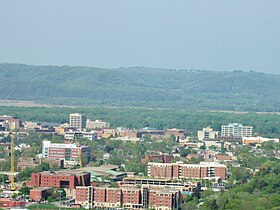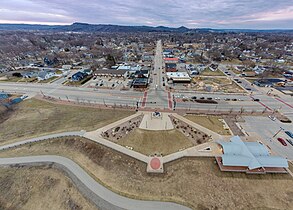La Crosse–Onalaska
Appearance
La Crosse–Onalaska | |
|---|---|
| La Crosse–Onalaska, WI–MN Metropolitan Statistical Area | |
 | |
| Country | |
| States | |
| Largest city | La Crosse, WI |
| Other cities | Onalaska, WI Holmen, WI La Crescent, MN Sparta, WI |
| Area | |
| 1,003.8 sq mi (2,600 km2) | |
| Highest elevation | 1,410 ft (430 m) |
| Lowest elevation | 626 ft (191 m) |
| Population (2020) | |
| • Urban | 98,872 (314th) |
| • MSA | 170,341 (256th) |
| • CSA | 216,389 (140th) |
| Time zone | UTC-6 (CST) |
| • Summer (DST) | UTC-5 (CDT) |
| Area code(s) | 608 and 507 |
| Interstates | |
| Public Transit | La Crosse MTU SMRT |
| Website | engagegreaterlacrosse.org |
The La Crosse–Onalaska Metropolitan Statistical Area, as defined by the United States Census Bureau, is an area consisting of La Crosse County, Wisconsin, Vernon County, Wisconsin, and Houston County, Minnesota, anchored by the cities of La Crosse and Onalaska. The area is part of what is commonly referred to as the Coulee Region or 7 Rivers Region. As of the 2020 census, the MSA had a population of 170,341, and in 2023 estimates placed the total population at 170,238.[1] The La Crosse-Onalaska-Sparta combined statistical area has a population of 216,389 as of 2023.
Counties
Communities
Places with more than 50,000 inhabitants
- La Crosse, WI (Principal city)
Places with 5,000 to 20,000 inhabitants
Places with 1,000 to 5,000 inhabitants
Places with fewer than 1,000 inhabitants
- Brownsville, MN
- Chaseburg, WI
- Coon Valley, WI
- De Soto, WI
- Eitzen, MN
- Genoa, WI
- Hokah, MN
- Houston, MN
- La Farge, WI
- Ontario, WI
- Readstown, WI
- Rockland, WI
- Stoddard, WI
- Viola, WI
Unincorporated places
- Barre Mills, WI
- Burns, WI
- Campbell, WI
- Farmington, WI
- French Island, WI
- Greenfield, WI
- Hamilton, WI
- Holland, WI
- Medary, WI
- Mindoro, WI
- Shelby, WI
- Stevenstown, WI
- Washington, WI
Population
| Census | Pop. | Note | %± |
|---|---|---|---|
| 1860 | 29,838 | — | |
| 1870 | 53,878 | 80.6% | |
| 1880 | 66,640 | 23.7% | |
| 1890 | 78,565 | 17.9% | |
| 1900 | 86,748 | 10.4% | |
| 1910 | 86,409 | −0.4% | |
| 1920 | 87,620 | 1.4% | |
| 1930 | 96,837 | 10.5% | |
| 1940 | 104,328 | 7.7% | |
| 1950 | 109,928 | 5.4% | |
| 1960 | 114,716 | 4.4% | |
| 1970 | 122,581 | 6.9% | |
| 1980 | 135,080 | 10.2% | |
| 1990 | 142,018 | 5.1% | |
| 2000 | 154,894 | 9.1% | |
| 2010 | 163,438 | 5.5% | |
| 2020 | 170,341 | 4.2% | |
| 2023 (est.) | 170,238 | [1] | −0.1% |
| U.S. Decennial Census[2] 2020 Census | |||
Transportation
Highways
Interstate Highways
US Highways
Minnesota State Highways
 Minnesota State Highway 16
Minnesota State Highway 16 Minnesota State Highway 26
Minnesota State Highway 26 Minnesota State Highway 44
Minnesota State Highway 44 Minnesota State Highway 76
Minnesota State Highway 76
Wisconsin State Highways
 Highway 16 (Wisconsin)
Highway 16 (Wisconsin) Highway 27 (Wisconsin)
Highway 27 (Wisconsin) Highway 33 (Wisconsin)
Highway 33 (Wisconsin) Highway 35 (Wisconsin)
Highway 35 (Wisconsin) Highway 56 (Wisconsin)
Highway 56 (Wisconsin) Highway 80 (Wisconsin)
Highway 80 (Wisconsin) Highway 82 (Wisconsin)
Highway 82 (Wisconsin) Highway 108 (Wisconsin)
Highway 108 (Wisconsin) Highway 131 (Wisconsin)
Highway 131 (Wisconsin) Highway 157 (Wisconsin)
Highway 157 (Wisconsin) Highway 162 (Wisconsin)
Highway 162 (Wisconsin)
Transit
Railroads
Public Airports
Commercial
General Aviation
Cities
Primary
Onalaska was promoted as a principal city of the MSA when the Office of Management and Budget revised the definitions of metropolitan statistical areas in 2013.[3]
See also
References
- ^ a b c "Metropolitan and Micropolitan Statistical Areas Population Totals and Components of Change: 2020-2023". United States Census Bureau. United States Census Bureau. Retrieved May 26, 2024.
- ^ "U.S. Decennial Census". Census.gov. Archived from the original on May 7, 2015. Retrieved May 19, 2013.
- ^ "Revised Delineations of Metropolitan Statistical Areas, Micropolitan Statistical Areas, and Combined Statistical Areas, and Guidance on Uses of the Delineations of These Areas" (PDF). Office of Management and Budget. February 28, 2013. Archived (PDF) from the original on February 7, 2017. Retrieved February 4, 2016.





